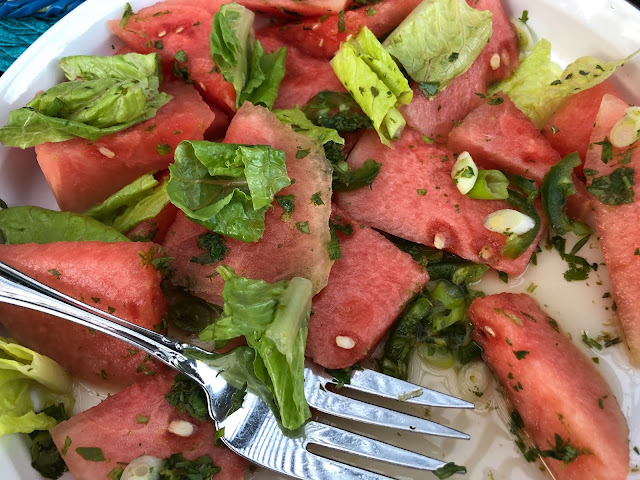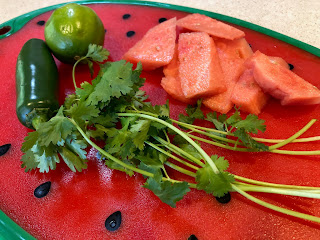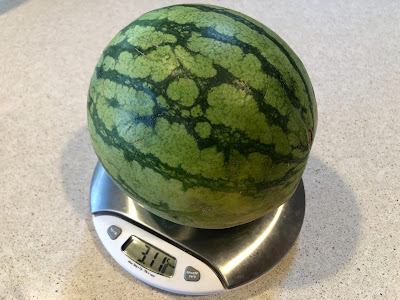
Recipe: A pop of heat combines with cool watermelon
 |
| Watermelon, peppers and lime make a great summer salad. (Photos: Kathy Morrison) |
Watermelon is an under-appreciated savory ingredient. Standard green salads are great, but you can hardly call them refreshing. Toss in some cold watermelon chunks, and wow. (It is a relative of cucumber, after all.)
This salad takes things a step further by putting the watermelon front and center, and then adding ingredients that complement it. Looking at the ingredients list, you might be reminded of salsa, but there’s not nearly the chopping involved.

|
I adapted this from an Epicurious recipe that includes jicama. I’m not a big fan of jicama, which strikes me as chalky even when it's fresh. I substituted the crispest pieces from a head of romaine lettuce. Lots of crunch without the flavorless chunks of jicama getting in the way.
This is ideal to serve at the 4th of July cookout as a contrast to the potato salad. Any leftovers hold up well in the refrigerator, too.
Spiced watermelon salad
Serves 4-6
Ingredients:
One 3- to 4-pound seedless watermelon, preferably chilled if serving immediately
4 or 5 romaine lettuce leaves, washed and dried — the crispest ones in the head or in the package
1 large or 2 small jalapeño peppers, thinly sliced (remove the seeds if you like it less spicy)
1 or 2 scallions, sliced on diagonal, white and light green parts only
1/2 cup coarsely chopped cilantro
3 tablespoons fresh lime juice
Coarse sea salt, to taste
Instructions:

This watermelon is a few ounces under 4 pounds. For reference, the scale's
diameter is 7.5 inches
|
Cut watermelon in half, then in quarters. Slice off and discard the rind on one of the quarters. (Rind is great compost material — just saying.) Cut off shards (thin, not chunks) of watermelon, arranging them on a large plate or serving dish. You may not need all the watermelon, depending on its size and the size of your serving dish, so work with just one quarter at a time.
Break up the romaine leaves and scatter them over the watermelon. Toss the other ingredients together in a small bowl and drizzle the mixture over the watermelon and romaine pieces. Serve immediately or cover and chill until serving time.
Note: Want to know how to choose a good little watermelon? The ones at the farmers markets usually are ready to go, but the watermelons at the supermarket are a mixed bag. Look for:
1. A melon heavy for its size with a dull, not shiny, skin. It should have a regular shape, whether round or somewhat oval.
2. A "field patch" of creamy white to yellow on one side, with yellow being best. This means the melon ripened on the ground. Avoid any without a patch.
3. Look for light scarring or dots on the melon. This is from bees, who know sweet.
4. Tiny dried sugar deposits on the stem end also indicate sweetness.
(Thumping a small watermelon is almost impossible, so leave that for the big melons.)
Comments
0 comments have been posted.Sacramento Digs Gardening to your inbox.
Sites We Like
Garden Checklist for week of April 21
This week there’s plenty to keep gardeners busy. With no rain in the immediate forecast, remember to irrigate any new transplants.
* Weed, weed, weed! Get them before they flower and go to seed.
* April is the last chance to plant citrus trees such as dwarf orange, lemon and kumquat. These trees also look good in landscaping and provide fresh fruit in winter.
* Smell orange blossoms? Feed citrus trees with a low dose of balanced fertilizer (such as 10-10-10) during bloom to help set fruit. Keep an eye out for ants.
* Apply slow-release fertilizer to the lawn.
* Thoroughly clean debris from the bottom of outdoor ponds or fountains.
* Spring brings a flush of rapid growth, and that means your garden is really hungry. Feed shrubs and trees with a slow-release fertilizer. Or mulch with a 1-inch layer of compost.
* Azaleas and camellias looking a little yellow? If leaves are turning yellow between the veins, give them a boost with chelated iron.
* Trim dead flowers but not leaves from spring-flowering bulbs such as daffodils and tulips. Those leaves gather energy to create next year's flowers. Also, give the bulbs a fertilizer boost after bloom.
* Pinch chrysanthemums back to 12 inches for fall flowers. Cut old stems to the ground.
* Mulch around plants to conserve moisture and control weeds.
* From seed, plant beans, beets, cantaloupes, carrots, corn, cucumbers, melons, radishes and squash.
* Plant onion sets.
* In the flower garden, plant seeds for asters, cosmos, celosia, marigolds, salvia, sunflowers and zinnias.
* Transplant petunias, zinnias, geraniums and other summer bloomers.
* Plant perennials and dahlia tubers for summer bloom.
* Mid to late April is about the last chance to plant summer bulbs, such as gladiolus and tuberous begonias.
* Transplant lettuce seedlings. Choose varieties that mature quickly such as loose leaf.